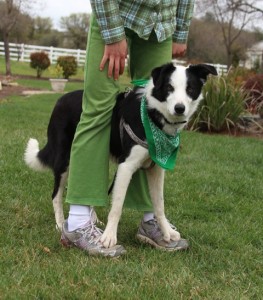When clipping the leash onto your dog’s collar just before a walk, you may not be aware of the dangers and risks of possible injury that you are exposing your dog to. Many people don’t realize that pressure on a dog’s collar, if the dogs pulls, can cause serious neck injuries. Just like a human’s neck, a dog’s neck is fragile. Maybe your dog doesn’t pull, but you never know when he could react to something and lunge. And there might be a situation where you have to pull your dog away from something dangerous and you wouldn’t want that pressure to go on their neck.
Choke chains, prong collars, slip leads and martingale collars are not only inhumane, but they can cause serious injury to your dog’s neck. Pressure on a dog’s neck sends stress hormones to the brain, making the dog more aroused, so attempts to correct an aggressive (barking at other dogs) or excitement behavior (like jumping on people) with a jerk just makes the behavior worse. Pressure on the neck restricts blood-flow to the brain and also can obstruct breathing because the collar rests right by the larynx. That is why you hear dogs hacking when they are pulling really hard.

This is a martingale collar with a nylon leash attachment
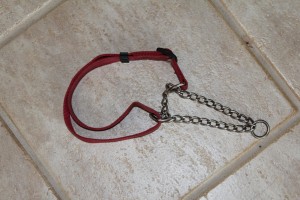
This is a martingale collar with a chain leash attachment
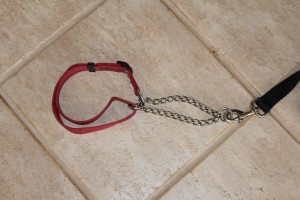
Martingale chain leash attachment with leash clipped on
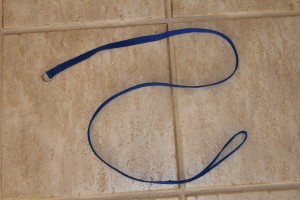
Slip lead
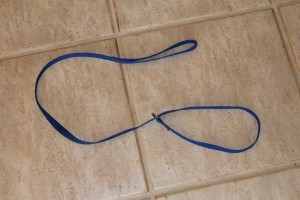
Slip lead - Slip leads are used in Agility and other dog sports where a collar or harness would be in the way and take too long to put on and take off. A slip lead is like a leash and collar in one.
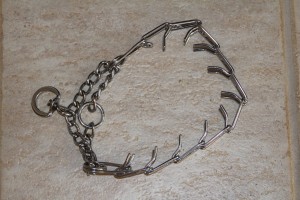
Prong Collar - Prong collars are used to give corrections by jerking on the leash that is attached to the collar. The prong collar is supposedly more humane than a choke chain, but really has the same risk factors.
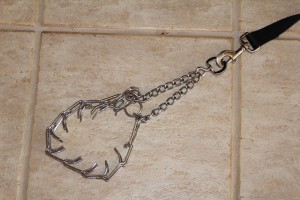
Prong collar with leash clipped on
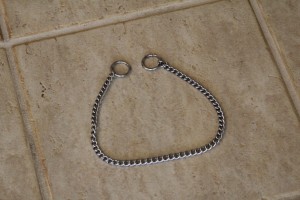
Choke chain

How the choke chain works: The chain goes through the loop.
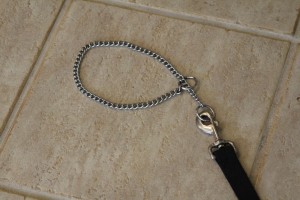
Choke chain with leash attached
Using these collars causes stress on your dog, decreasing their quality of life, however not only are these collars bad, but your dog’s regular collar can injure your dog just as these choking devices do.
In conclusion, when going for a walk a leash should never be attached to your dog’s regular collar, or to any other choking device and you should not use a slip lead. The best piece of equipment to use is a harness. Harnesses may be more expensive and take longer to put on, but they are more secure, and most importantly, are not causing any damage to your dog if he pulls or lunges.
A common misconception of harness is that harnesses teach your dog to pull. This is partially true. While walking forward as your dog is pulling (no matter what the dog is wearing) will reinforce pulling on a leash, a back clipping harness is reinforcing for dogs to pull into and it also gives them more leverage to pull you. A simple solution is to either not walk forward while your dog is pulling (stop or turn around when your dog pulls) or clip the harness in the front. A harness like this one, is great because if you have a strong dog who likes to pull, you can clip the leash in the front, giving your dog less leverage to pull you.
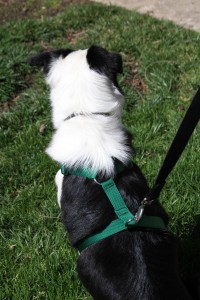
Tessa models the Roman Harness clipped onto the back loop
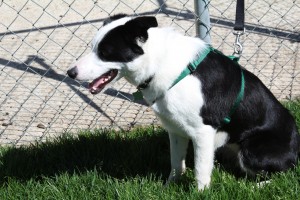
The Roman Harness clipped at the back
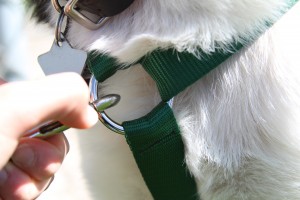
For large dogs that pull, clip the leash to the loop in the front of the harness. This gives the dog less leverage to pull.

Tessa demonstrates how the leash can be clipped to the front of the harness. Notice how happy Tessa is to model the harness, she wouldn't be smiling if I was demonstrating a martingale or prong collar.
When I found out what risks there are to walking your dog on a collar, using choke collars or slip leads, I decided that I will never attach the leash to our dogs’ collars. Even though they walk well on the leash, it is not worth the risk.
If you are ready to make the decision to buy a harness, I would suggest that you buy a Roman harness. Amazon has great prices on harnesses.
If you have any questions about harnesses, collars or any piece of equipment that you would attach the leash to, please email me at clickerpets@ymail.com. Thanks!














